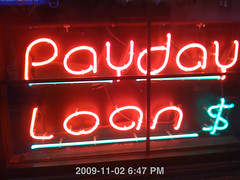- RT @MoneyMatters: Frugal teen buys house with 4-H winnings http://bit.ly/amVvkV #
- RT @MoneyNing: What You Need to Know About CSAs Before Joining: Getting the freshest produce available … http://bit.ly/dezbxu #
- RT @freefrombroke: Latest Money Hackers Carnival! http://bit.ly/davj5w #
- Geez. Kid just screamed like she'd been burned. She saw a woodtick. #
- "I can't sit on the couch. Ticks will come!" #
- RT @chrisguillebeau: U.S. Constitution: 4,543 words. Facebook's privacy policy: 5,830: http://nyti.ms/aphEW9 #
- RT @punchdebt: Why is it “okay” to be broke, but taboo to be rich? http://bit.ly/csJJaR #
- RT @ericabiz: New on erica.biz: How to Reach Executives at Large Corporations: Skip crappy "tech support"…read this: http://www.erica.biz/ #
The Magic Toilet

- Image by tokyofortwo via Flickr
My toilet is saving me $1200.
For a long time, my toilet ran. It was a nearly steady stream of money slipping down the drain. I knew that replacing the flapper was a quick job, but it was easy to ignore. If I wasn’t in the bathroom, I couldn’t hear it. If I was in the bathroom, I was otherwise occupied.
When I finally got sick of it, I started researching how to fix a running toilet because I had never done it before. I found the HydroRight Dual-Flush Converter. It’s the magical push-button, two-stage flusher. Yes, science fiction has taken over my bathroom. Or at least my toilet.
I bought the dual-flush converter, which replaces the flusher and the flapper. It has two buttons, which each use different amounts of water, depending on what you need it to do. I’m sure there’s a poop joke in there somewhere, but I’m pretending to have too much class to make it.
I also bought the matching fill valve. This lets you set how much water is allowed into the tank much better than just putting a brick in the tank. It’s a much faster fill and has a pressure nozzle that lies on the bottom of the tank. Every time you flush, it cleans the inside of the tank. Before I put it in, it had been at least 5 years since I had opened the tank. It was black. Two weeks later, it was white again. I wouldn’t want to eat off of it, or drink the water, but it was a definite improvement.
Installation would have been easier if the calcium buildup hadn’t welded the flush handle to the tank. That’s what reciprocating saws are for, though. That, and scaring my wife with the idea of replacing the toilet. Once the handle was off, it took 15 minutes to install.
“Wow”, you say? “Where’s the $1200”, you say? We’ve had this setup, which cost $35.42, since June 8th, 2010. It’s now September. That’s summer. We’ve watered both the lawn and the garden and our quarterly water bill has gone down $30, almost paying for the poo-gadget already. $30 X 4 = $120 per year, or $1200 over 10 years.
Yes, it will take a decade, but my toilet is saving me $1200.
How to Prioritize Your Spending
Don’t buy that.
At least take a few moments to decide if it’s really worth buying.
Too often, people go on auto-pilot and buy whatever catches their attention for a few moments. The end-caps at the store? Oh, boy, that’s impossible to resist. Everybody needs a 1000 pack of ShamWow’s, right? Who could live without a extra pair of kevlar boxer shorts?
Before you put the new tchotke in your cart, ask yourself some questions to see if it’s worth getting.
1. Is it a need or a want? Is this something you could live without? Some things are necessary. Soap, shampoo, and food are essentials. You have to buy those. Other things, like movies, most of the clothes people buy, or electronic gadgets are almost always optional. If you don’t need it, it may be a good idea to leave it in the store.
2. Does it serve a purpose? I bought a vase once that I thought was pretty and could hold candy or something, but it’s done nothing but collect dust in the meantime. It’s purpose is nothing more than hiding part of a flat surface. Useless.
3. Will you actually use it? A few years ago, my wife an cleaned out her mother’s house. She’s a hoarder. We found at least 50 shopping bags full of clothes with the tags still attached. I know, you’re thinking that you’d never do that, because you’re not a hoarder, but people do it all the time. Have you ever bought a book that you haven’t gotten around to reading, or a movie that went on the shelf, still wrapped in plastic? Do you own a treadmill that’s only being used to hang clothes, or a home liposuction machine that is not being used to make soap?
3. Is it a fad? Beanie babies, iPads, BetaMax, and bike helmets. All garbage that takes the world by storm for a few years then fades, leaving the distributors rich and the customers embarrassed.
4. Is it something you’re considering just to keep up with the Joneses? If you’re only buying it to compete with your neighbors, don’t buy it. You don’t need a Lexus, a Rolex, or that replacement kidney. Just put it back on the shelf and go home with your money. Chances are, your neighbors are only buying stuff so they can compete with you. It’s a vicious cycle. Break it.
5. Do you really, really want it? Sometimes, no matter how worthless something might be, whether it’s a fad, or a dust-collecting knick-knack, or an outfit you’ll never wear, you just want it more than you want your next breath of air. That’s ok. A bit disturbing, but ok. If you are meeting all of your other needs, it’s fine to indulge yourself on occasion.
How do you prioritize spending if you’re thinking about buying something questionable?
Discount Gift Cards: How Much Can You Save?

Do you know where you shop regularly?
Would you be happy if the things you bought there were suddenly, magically discounted?
It could happen.
I don’t think the game store down the road is suddenly going to institute a “Jason Rocks” discount program, but some of the bigger chains I visit have an unofficial option that can save you money, and it’s not a five-finger discount.
You can buy discounted gift cards. You can find a gift card exchange being run on a number of websites. How does it work?
There are two kinds of card exchange.
The first simply connects buyers and sellers. If you want to buy a gift card, you browse the list of available cards until you find something you like. You place your order with the exchange, who then take a fee and pass the rest of the payment to the seller, who’s got the job of sending it to you. When you get the card, you get to find out if the balance still exists or if it’s going to expire in the morning. Most people don’t sell a lot of gift cards, so their reputation isn’t really at stake. Avoid these, unless you like gambling.
The second kind of exchange actually buys the cards from the sellers and verifies the balance and expiration date before posting them for sale. When you go shopping, you’re dealing with a company that is putting its reputation–both with its customers and its bank–on the line. If there’s a problem, you’ve got someone to contact who probably isn’t going to vanish.
You visit the site, find a business you want to visit, and buy a card at a discount. The discount ranges from around 3% up to around 30%, with most discounts hovering around 10%. That means–depending on the store–you can get a $100 gift card for $90. Not a bad deal, especially if it for a store you’d be visiting anyway.
Have you ever bought a second-hand gift card? How did it work for you?
Why I Hate Payday Loans
I hate payday loans and payday lenders.
The way a way a payday loan works is that you go into a payday lender and you sign a check for the amount you want to borrow, plus their fee. They give you money that you don’t have to pay back until payday. It’s generally a two-week loan.
Now, this two week loan comes with a fee, so if you want to borrow $100, they’ll charge you a $25 fee, plus a percent of the total loan, so for that $100 loan, you’ll have to pay back $128.28.
That’s only 28% of actual interest; that’s not terrible. However, if you prorate that to figure the APR, which is what everyone means when they say “I’ve got a 7% interest rate”, it comes out to 737%. That’s nuts.
They are a very bad financial plan.
Those loans may save you from an overdraft fee, but they’ll cost almost as much as an overdraft fee, and the way they are rigged–with high fees, due on payday–you’re more likely to need another one soon. They are structured to keep you from ever getting out from under the payday loan cycle.
For those reasons, I consider payday loan companies to be slimy. Look at any of their sites. Almost none are upfront about the total cost of the loan.
So I don’t take their ads. When an advertiser contacts me, my rate sheet says very clealy that I will not take payday loan ads. The reason for that is–in my mind–when I accept an advertiser, I am–in some form–endorsing that company, or at least, I am agreeing that they are a legitimate business and I am helping them conduct that business.
In all of the time I’ve been taking ads, I’ve made exactly one exception to that rule. On the front page of that advertiser’s website, they had the prorated APR in bright, bold red letters. It was still a really bad deal, but with that level of disclosure, I felt comfortable that nobody would click through and sign up without knowing what they were getting into. That was a payday lender with integrity, as oxymoronic as that sounds.
Sammy’s Story, Part 2
For those of you not following along, please read the previous installment of Sammy’s Story. The short version is that we’re thinking about helping someone launch a small business and put “at risk” teenagers and young adults to work.
Sammy called me a couple of days ago. He wanted to discuss working for some of the tools and toys he saw at my mother-in-law’s house and he said he had something to show us. When I picked him up, he had a leather portfolio-style notebook and looked excited.
When we got to the house, he opened up his notebook and handed me two pieces of paper. He said that the idea of being able to launch his business had him so excited that he couldn’t not do anything. He had handed me a landscaping plan and materials list for fixing my mother-in-law’s yard.
We talked about the landscape plan, the business plan, and my wife’s old skateboard, then he had to go. Last night was one of the nights he met “his” kids at a community center.
On the way to the community center, we stopped by his apartment, because he wanted to show me pictures of his kids, and his grandkids, and his foster mother. He told me about his mother dying when he was 13 and his father dropping him with an aunt before disappearing. He was nearly in tears when he asked how some strange white guy could see more in him than his own family did.
He told me about how the money he made working with me had put food on the table of the 14 year old he brought with–a 14 year old who is eager to work more. It paid the weekly rent for one of the other workers and contributed to the rehab of Sammy’s ex. The little bit we’ve done has already touched the lives of dozens of people.
We talked about the way he hates rap. Not because of it’s musical value, but because it’s building a culture that considers women to be nothing but “bitches and hoes” while convincing kids that the only way they can improve their situation is to land a recording contract. Those are the kids he wants to teach to take care of themselves and build their own lives.
Finally, he asked me for my honest opinion about his landscaping plan.
I said, “Sammy, that clinched the deal. I was leaning towards helping you, but now it’s definite. I know you’re serious, so we’re going to make this happen.”
He’s got no idea how to handle taxes, payroll, or insurance, and he has no tools, but we’re going to jump in with both feet.





